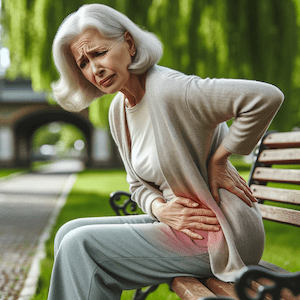Hip Arthritis (Osteoarthritis)
Article by J. Miller, S.Armfield

Hip Arthritis
A Comprehensive Guide from a Physiotherapist’s Perspective
What is Hip Osteoarthritis?
Hip osteoarthritis (hip OA), also known as hip arthritis, marks a significant health concern. It’s a degenerative joint disease primarily characterised by the breakdown of cartilage in the hip joint. This deterioration leads to bones rubbing together, causing pain, stiffness, and reduced mobility. Although the exact cause of hip OA remains unclear, factors like age, genetics, obesity, joint injuries, and repetitive stress contribute to its development.
Hip Arthritis Management
Physiotherapy, stretching, and low-impact exercises such as walking, swimming, and cycling significantly benefit those with hip OA. Assistive devices like walking sticks or wheeled-walkers also support the hip joint and reduce pain while walking. Furthermore, maintaining a healthy weight is vital, as excess weight exacerbates the strain on your hip joint. Exercise can help strengthen your hip joint muscles, increase flexibility, and alleviate pain.
In cases where conservative treatments fail, surgery, such as hip replacement, might be necessary. Your physiotherapist and doctor will collaborate to determine the best treatment plan for you.
The Causes of Hip Osteoarthritis
Hip OA stems from a combination of factors. The primary cause is the breakdown and wear of cartilage and cortical bone in the hip joint. Age, obesity, joint injuries, muscle weaknesses and imbalances, repetitive stress, and genetic factors also play significant roles.
Early intervention and management can delay the onset and reduce the severity of symptoms. Key preventive measures include maintaining a healthy weight, staying active with low-impact exercise, and seeking medical treatment for injuries or joint pain.
Hip OA Symptoms
Common symptoms of hip OA include hip pain, often felt in the groin area, stiffness, reduced range of motion, and in some cases, swelling or deformity in the joint. It’s crucial to consult with a healthcare professional for an accurate diagnosis and appropriate treatment plan.
Diagnosing Hip Osteoarthritis
Diagnosis typically involves patient history, physical examination, and diagnostic tests such as X-rays, CT scans, or MRIs. Your healthcare professional will assess your hip joint and may use blood tests to rule out other conditions.

Physiotherapy: An Effective Approach
Recent studies underscore the effectiveness of physiotherapy in treating hip OA. Patient education, manual therapy, and exercise therapy have shown significant improvement in symptoms and delayed the need for hip replacement surgery.
Comprehensive Treatment Guidelines
Managing hip OA involves various rehabilitation phases. Phase I focuses on pain relief, Phase II aims to restore normal hip function, Phase III involves fine-tuning hip stability and function, and Phase IV focuses on delaying hip surgery.
In severe cases, Phase V, hip surgery, may be recommended. Post-operative hip strengthening and rehabilitation are crucial to prolong the life of your new hip.
Taking Care of Your Hips
To manage symptoms and improve your quality of life, maintain a healthy weight, apply ice to reduce inflammation, engage in regular exercise, and strengthen your bones. Massage therapy can also relieve muscle stiffness and pain. Follow your healthcare practitioner’s advice, including prescribed medications and exercises, to improve hip health.
Conclusion: Seek Professional Advice
Hip osteoarthritis can significantly impact your quality of life. However, with the right approach, including physiotherapy, exercise, and possibly surgery, you can manage the symptoms effectively. Remember, each individual’s situation is unique, so it’s crucial to seek the advice of your physiotherapist to tailor a treatment plan to your specific needs. They are your partners in navigating the journey to better hip health and improved quality of life.
]
































































